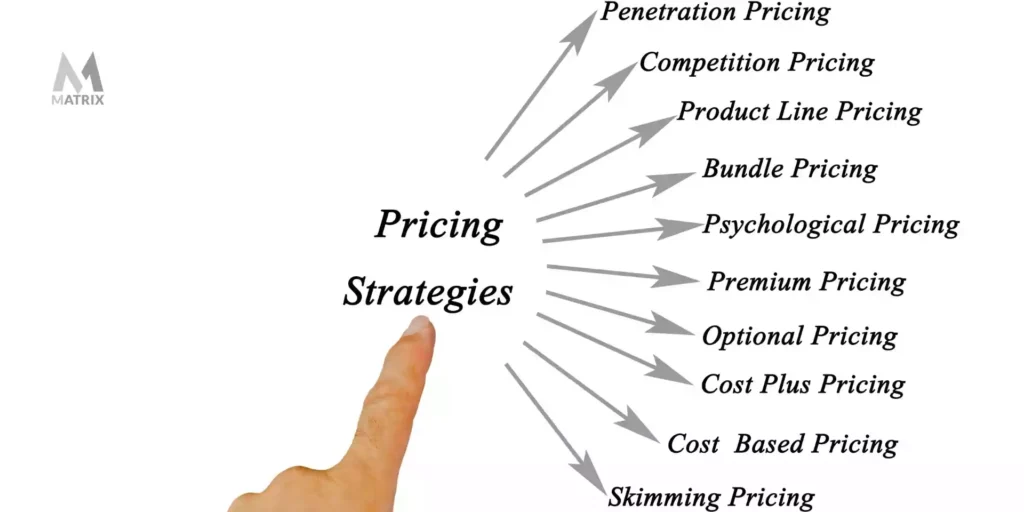New product price strategies are critical before product introduction.
Learn about new product price strategies that will lead to explosive growth.
Introducing a new product to the market can be daunting. You must worry about designing and manufacturing a quality product.
Still, you must also develop an effective pricing strategy that allows you to make a profit while still competing with other brands.
There are several ways to price a new product; the best option for your business depends on various factors. You will see pricing strategies with examples, pricing models, and pricing strategies marketing, and you can download this post in the pricing strategies pdf.
One common pricing strategy for new products is skimming. This involves setting a high price for the product to maximize profits early.
While this can be an effective strategy, it can also backfire if customers perceive the product as overpriced and are unwilling to pay for it.
Another option is to penetrate the market at a lower price. This can help you attract more customers and boost sales in the short term, but it may not be sustainable in the long run if your competitors can undercut you on price.
Introducing a new product to the market can be a daunting task. You have to worry about designing and manufacturing a quality product. Still, you also have to develop an effective pricing strategy that will allow you to make a profit while competing with other brands. What are Digital Marketing Services?
Explain new product pricing strategies to the sales teams.
Here’s some fresh and engaging copy on new product pricing strategies that dives into the nuances and unspoken truths often overlooked:
The Hidden Art of Pricing: Why Your Product’s Price Tag is the Last Thing You Should Worry About
In today’s saturated market, everyone discusses pricing models like cost-plus, penetration, and skimming. But let’s flip the script—because the real magic happens before you even slap that price tag on your product. It’s not about undercutting the competition or finding the ‘sweet spot’ everyone else is chasing. It’s about understanding the psychology behind your customer’s decision-making process.
Consider this: Pricing is less about the number and more about the narrative it tells. A new product’s price isn’t just a reflection of its value—it’s a signal, a promise, and, more importantly, a story. And here’s where most brands get it wrong: they focus too much on what they think customers can afford rather than what customers are willing to pay for the experience.
In a world where premium is the new normal, your next pricing strategy shouldn’t be about offering the lowest price—but the most aspirational one. How do you price a product for a market tired of being sold to? You don’t price it for them—you price it with them. Invite your customers into the process. Let them see the value they’re getting, not just the cost.
When everyone else races to the bottom, dare to stay at the top. Not because you want to be exclusive but because you understand that the true value of your product isn’t just in the materials or the labor—it’s in the perception you create and the belief you instill.
So next time you think about pricing your product, ask yourself: Are you selling a price or a story?”
This approach shifts the focus from traditional pricing strategies to the psychology and storytelling aspect behind pricing, which is often under-discussed.
There are several ways to price a new product; the best option for your business depends on various factors.
How are prices set? In the past, prices were set by buyers and sellers negotiating with each other. Sellers would ask for a higher price than expected, and buyers would offer less. Through bargaining, they would arrive at an acceptable price.
The strategic importance of price demonstrates how products, distribution, price, and promotion strategies will fit together into an integrated program positioning strategy.
Analyzing the pricing situation is necessary to develop a price strategy for a new product mix or line or select a price strategy for a new product or brand.
Several important strategic activities, including product market analysis, cost, competition, and legal and ethical considerations, underlie strategy formulation.

Pricing is a problem when a company has to set a price for the first time.
This happens when:
- The company develops or acquires a new product
- When it introduces its regular product into a new distribution channel or geographical area
- When it enters bids on new contract work
Analysis of the pricing situation provides useful information for pricing new products.
Additional considerations in deciding about prices include:
- Determining price flexibility
- Deciding how to position price relative to the cost
- Deciding how visible to make the price of the new products
- Establishing price policies and structure
Pricing approaches for new products include:
- High-active
- High-passive
- Low active
- Low passive strategies
Variations within the four categories occur. In many industries, marketing managers establish prices, followed by other companies.
Special pricing considerations include price segmentation, distribution channel pricing, product lifecycle pricing, and price and quality relationships. Specific prices may be determined based on cost, competition, and/or demand influences.
Who is responsible for new product introductions?

The responsibility for new product introductions generally falls on the company’s marketing or product development teams.
These teams must develop a profitable and competitive pricing strategy. They must also ensure the product is well-designed and manufactured to meet quality standards.
What are the problems with pricing new products to watch for?
One common problem with pricing new products is that companies can incur losses if they set the price too low. Check out aiprodpad.com for real results and product launches cut in half.
Another issue is that customers may be unwilling to purchase the product if the price is too high. It’s also important to consider the cost of goods sold and ensure that the product’s price covers all associated expenses.
Failing to do so can lead to financial losses for the company.
The Six-step Procedure for Setting New Product Pricing

The company has to consider many factors when setting its pricing policy. Here’s a quick six-step procedure for setting price pricing for new products.
- Selecting the pricing objectives
- Determine the demand for sales volume
- Estimating cost
- Analyzing competitor’s prices and offers
- Selecting a pricing method
- Selecting the final price point
A good marketing manager can determine the demand, even with the new product activity in the target market.
How Much Flexibility Exists in Pricing New Products?

Demand and cost aspects determine the extent of price flexibility. Within these upper and lower boundaries, competition, among the legal and ethical considerations, may influence the choice of a specific price strategy.
The flexibility range for a price between demand and cost may be narrow or wide. A wide gap suggests a greater range of visible strategies. Exhibit 1 illustrates how these factors determine flexibility.
The choice of a price strategy within the gap is influenced by competitive strategies and future, present, legal, and ethical considerations. Management must determine where the price is within the gap.
In competitive markets, the feasibility range may be very narrow. New markets are emerging segments in established markets that may allow our firm substantial flexibility in strategy selection.
The price band for a product indicates the amount of flexibility and pricing compared to the competition.
It is a function of:
- Competitive intensity
- The value of the brand as perceived by buyers
Commodity-type brands have a narrow price band. Since buyers consider all commodity brands equivalent, they will move to the lowest price for a commodity item.
Price Positioning and Visibility
A key decision is how high to price a new product within the flexibility band. Companies can charge a relatively low entry price to build volume and market position or set a high price to generate large margins.
The former is a penetration strategy, whereas the latter is a price-skimming strategy. A lack of knowledge about previous market responses to the new product complicates the pricing decision.
Several factors may affect the choice of a pricing approach for a new product, including:
- The cost and the estimated lifespan of the product
- The estimated responsiveness of buyers to alternative prices
- Assessment of competitive reactions
A decision should also be made about how visible the price will be in promoting the new product. Using a low entry price requires actively promoting the price to gain market position.
When companies use a higher price relative to cost, the price often assumes a passive role in marketing the new product and market penetration. Instead, the performance and other attributes of the product are stressed in the marketing program positioning strategy.
Price Policy and Price Structure
Determining your price flexibility, positioning your price against the competition, and deciding how to activate the marketing component in the marketing programs are also necessary to determine policies and price structure. This does not establish the operating guidelines necessary for implementing the price policy.
Price is a focal point of the company’s positioning strategy. Anytime more than one product is involved, the company must determine product mix and line pricing into relationships to establish a price structure.
And when more than one target market is involved, the relationships exist between the products offered in each? Assuming product differences, should the price be based on cost, demand, or competition?
Price structure considers how individual items in the product line are priced relative to one another. Each item may be aimed at the same target market or user groups. Denver Digital Marketing Agencies are Failing Their Clients.
For example, department stores often offer economy or premium product categories. In a single-product market, price differences among products typically reflect more than variations in the cost.
Supermarket chains price for the total profitability of the product offering rather than for the performance of individual items. These retailers have developed computer analysis and pricing procedures to achieve sales, market share, economies of scale, and profit objectives.
Once product relationships are established, some basis for determining price structure must be selected. Many firms base price structure on the market, competitive factors, and differences in the cost of making each item.
Some use multiple criteria for determining price structure and have sophisticated computer models to examine alternative pricing schemes.
The following guidelines are used in pricing a product line:
- Price each product about all others. Noticeable differences in products should be equivalent to perceiving value differences
- The top and bottom prices in the line should be priced to foster desired buyer perceptions
- Price differences between products should become larger as price increases over the product line
Most approaches include not only cost considerations but also demand and competitive concerns. For example, industrial equipment manufacturers sometimes price new products at or near cost and depend on sales of high-margin items such as supplies, parts, and replacement items to generate profits. The important consideration is to price the entire product mix and line to achieve price objectives.
Now, let’s explore the price strategies in more detail.
Competitive Strategy and Positioning

The choice of a price strategy depends on how management decides to price the product relative to the competition and whether price plays an active or passive role in the marketing program. Price as an active or passive factor refers to whether prices are discussed in advertising, direct selling, and other promotional efforts.
Many companies choose to price at or near key competitors’ prices, and their marketing strategies emphasize non-price factors.
High Active Strategy and Price Strategies for New Products
This strategy is sometimes used for prestige brands seeking an affluent image. These companies can charge a premium price. When the buyer cannot easily evaluate the quality of a product, the price can serve as a signal of value.
High prices may be essential to gain the margins necessary to serve small target markets, produce high-quality products, or pay for developing new products.
Making prices visible and active can appeal to buyers’ perceptions of the quality, image, and dependability. A company using a high-price strategy is less subject to retaliation by competitors, particularly if its product can be differentiated.
High Passive Strategy
High-price items are more often marketed using non-price factors rather than highly active strategies. Product features and performance can be stressed when the target market is concerned with product quality and performance.
Low Active Strategy
Many retailers use a strategy, including Lowe’s, Dollar General stores, and Payless Shoes. A low active price strategy can be very effective when a price is an important factor in buyers’ decisions.
However, this strategy may start a price war. It is a more attractive option when the competition for the target market is not heavy or when a company has an advantage in a strong position in the product market.
Low Passive Strategy and Price Strategies for New Products
This strategy may be used by manufacturers whose products have more low-cost features than other suppliers. By not emphasizing low prices, the company runs less danger that potential buyers will assume the product quality is inferior to other brands.
Some firms participating in conventional channels may not spend much on marketing their products and may offer low prices because of lower costs. Other companies with actual cost advantages for comparable competing products may decide to stress value rather than price while offering prices lower than competing brands.
Wrap-Up about Price Strategies for New Products
The strategic importance of price demonstrates how products, distribution, price, and promotion strategies will fit together into an integrated program positioning strategy.
Analyzing the pricing situation is necessary to develop a price strategy for a product mix or product line or to select a price strategy for a new product or brand. Several important strategic activities, including product market analysis, cost, competition, and legal and ethical considerations, underlie strategy formulation.
These analyses indicate the extent of price flexibility. Price strategies are classified according to the company’s price relative to the competition and how active price promotion will be in the marketing program. Pricing strategies in marketing mix matter.
Pricing decisions for new products should consider price positioning alternatives and how price may be used as an active element in the marketing program. Price policies and structure must also be determined for new products. How to Create a Revenue Strategy in 7 Easy Steps
We’re Listening:
Have something to say about this article?
FAQs about Price Strategies for New Products
What is skimming, and how can it be used to price a new product?

Skimming is a pricing strategy in which a high price is set for the initial release of a new product to maximize profits.
What is penetration pricing, and when is it appropriate?

Penetration pricing is a pricing strategy in which a product is offered at a lower price to attract more customers and boost sales in the short term. It is typically used when a company faces stiff competition from other brands.
How does the cost of goods sold impact pricing decisions?

The cost of goods sold is a key factor in pricing decisions for new products. It is important to ensure that the product’s price covers the cost of manufacturing, distributing, and making a profit. If the price is too low, the company may not be able to cover its costs; if it is too high, customers may be unwilling to pay.
What are some common mistakes made when pricing new products?

One common mistake is setting the price too low, leading to losses in the long run. Another mistake is pricing the product too high, making it unattractive. It’s also important to consider the cost of goods sold and ensure that the product’s price covers all expenses. Not taking these factors into account can lead to financial losses.

